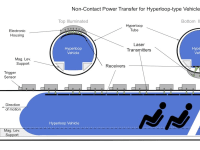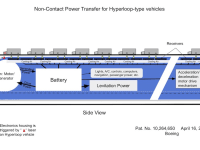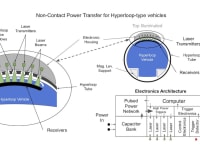This approach describes a technique to be able to transfer large amounts of electrical energy from a stable platform to a high velocity moving vehicle in a near vacuum environment with no physical contact. In some of the new Hyperloop type transport systems, large amounts of energy will need to be stored (batteries) or created (fuel based motors) to power the on-board functions required for the operation of the transport Hyperloop type vehicles. These ‘on-board’ functions include magnetic levitation, air compressors and pumping systems, lighting, heating and cooling of passenger volumes, control electronics, etc. The existing approaches (diesel engines, batteries, etc.) are a large factor in the ‘empty’ mass and volume of the vehicle, which means the amount of passengers and/or materials that can be transported is reduced. The existing approaches also increase the initial cost, maintenance cost, internal noise and vibrations of the vehicle.
The approach proposed in this system model is to mount on the outer shell of the vehicle, behind a window, a large set of optical photon-electric panels, conformal to the outer shell of the vehicle, which are optimized for a specific wavelength of light. Optical panels, made of specific materials, can have an optical conversion efficiency of up to over 80%. Power densities of 500 to over 1000 Watts/cm2 have been demonstrated by terrestrial solar energy systems. At various locations along the path of the Hyperloop tube, either mounted on the inside of the vacuum tube, or on the outside of the tube (through small windows), high powered pulsed lasers inject laser light, hitting the photon-electric panels as the vehicle passes. This light passes across the open space between the stationary source and the moving vehicle (traveling at speeds up to 600 mph) and converts that optical light to electrical power onboard the moving vehicle. The lasers would only be ‘on’ for less than 4 mSec to fully illuminate a vehicle that is 100 meters long, traveling at 600 mph. Pulsed lasers of this power and electro-optical panels of this power absorption level have been produced and are commercially available today. The electrical power can be used as the vehicle moves within the tube and/or stored in batteries (much smaller capacity that would be required for the ‘full’ trip). Depending on the usage requirements of the moving vehicle, the spacing of the lasers can be placed as needed. The high power laser sources will be triggered by the moving vehicle as it passes by the electronic housing. This sort of triggering can be done easily with cooperative hand shaking between vehicle and sources, even at these speeds. The on-board heat generated by this electrical generation and usage can be dissipated by the compressed air being passed from the front to the back of the vehicle. This energy collection process creates no sounds and no vibrations, and does not produce any exhaust gasses or soot that needs to be vented and purged from the tube. Everything on board can be electric.
Like this entry?
-
About the Entrant
- Name:Douglas Jungwirth
- Type of entry:individual
- Patent status:patented








